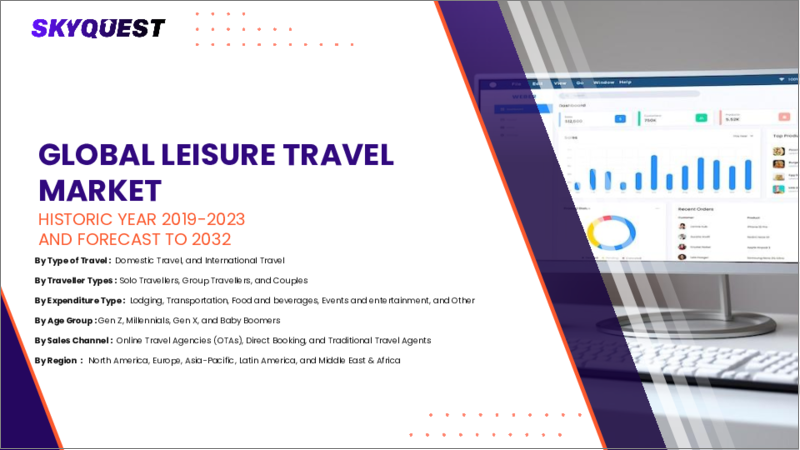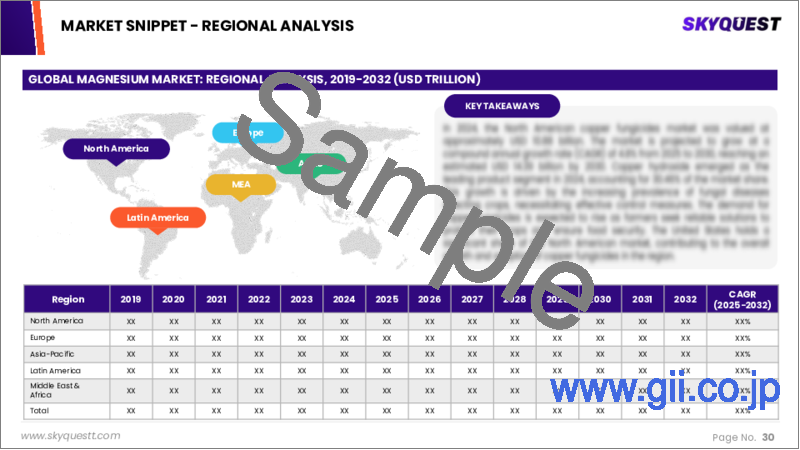|
|
市場調査レポート
商品コード
1654040
レジャー旅行の市場規模、シェア、成長分析:旅行者タイプ別、年齢層別、支出タイプ別、販売チャネル別、地域別 - 産業予測、2025年~2032年Leisure Travel Market Size, Share, and Growth Analysis, By Traveler Type (Solo, Group), By Age Group (Up to 20 Years, Between 20 and 40 Years), By Expenditure Type, By Sales Channel, By Region - Industry Forecast 2025-2032 |
||||||
|
|||||||
| レジャー旅行の市場規模、シェア、成長分析:旅行者タイプ別、年齢層別、支出タイプ別、販売チャネル別、地域別 - 産業予測、2025年~2032年 |
|
出版日: 2025年02月08日
発行: SkyQuest
ページ情報: 英文 157 Pages
納期: 3~5営業日
|
全表示
- 概要
- 目次
レジャー旅行の市場規模は2023年に9,500億米ドルとなり、2024年の1兆1,000億米ドルから2032年には3兆4,200億米ドルに成長し、予測期間(2025年~2032年)のCAGRは15.3%で成長する見通しです。
レジャー旅行市場は、COVID-19パンデミックによる大幅な低迷を経て、ダイナミックな進化を遂げています。パンデミック以前の成長は、思い出に残る休暇を熱望する中間層の増加によって牽引されていたが、旅行規制によって国際観光は激減しました。現在、国内旅行が自然やアウトドアアクティビティを重視するようになり、市場は回復しつつあります。安全への懸念が高まる中、旅行行動に影響を与える健康プロトコルは依然として極めて重要です。さらに、モバイルアプリやデジタルマーケティング戦略が顧客とのエンゲージメントを強化するなど、技術の進歩がこの分野の形を変えつつあります。冒険旅行、ウェルネスツーリズム、"ワーケーション"といったニッチ分野が台頭し、旅行者の没入型体験への欲求を反映しています。環境的に持続可能な慣行への業界の適応は、その回復力と現代の消費者の価値観への対応をさらに示しています。
目次
イントロダクション
- 調査の目的
- 調査範囲
- 定義
調査手法
- 情報調達
- 二次と一次データの方法
- 市場規模予測
- 市場の前提条件と制限
エグゼクティブサマリー
- 世界市場の見通し
- 供給と需要の動向分析
- セグメント別機会分析
市場力学と見通し
- 市場概要
- 市場規模
- 市場力学
- 促進要因と機会
- 抑制要因と課題
- ポーターの分析
主な市場の考察
- 主要成功要因
- 競合の程度
- 主な投資機会
- 市場エコシステム
- 市場の魅力指数(2024年)
- PESTEL分析
- マクロ経済指標
- バリューチェーン分析
- 価格分析
レジャー旅行の市場規模:旅行者タイプ別 & CAGR(2025年~2032年)
- 市場概要
- ソロ
- グループ
レジャー旅行の市場規模:年齢層別 & CAGR(2025年~2032年)
- 市場概要
- 20歳以下
- 20歳~40歳
- 40歳以上
レジャー旅行の市場規模:支出タイプ別 & CAGR(2025年~2032年)
- 市場概要
- 宿泊
- 輸送
- 食品・飲料
- イベント・エンターテイメント
- その他
レジャー旅行の市場規模:販売チャネル別 & CAGR(2025年~2032年)
- 市場概要
- 従来のチャネル
- オンラインチャンネル
レジャー旅行の市場規模 & CAGR(2025年~2032年)
- 北米
- 米国
- カナダ
- 欧州
- ドイツ
- スペイン
- フランス
- 英国
- イタリア
- その他欧州
- アジア太平洋
- 中国
- インド
- 日本
- 韓国
- その他アジア太平洋
- ラテンアメリカ
- ブラジル
- その他ラテンアメリカ
- 中東・アフリカ
- GCC諸国
- 南アフリカ
- その他中東・アフリカ
競合情報
- 上位5社の比較
- 主要企業の市場ポジショニング(2024年)
- 主な市場企業が採用した戦略
- 最近の市場動向
- 企業の市場シェア分析(2024年)
- 主要企業の企業プロファイル
- 企業の詳細
- 製品ポートフォリオ分析
- 企業のセグメント別シェア分析
- 収益の前年比比較(2022年~2024年)
主要企業プロファイル
- Booking Holdings(米国)
- Expedia Group(米国)
- Airbnb(米国)
- Trip.com Group(中国)
- MakeMyTrip(インド)
- Yatra(インド)
- Thomas Cook(英国)
- Cox & Kings(インド)
- SOTC Travel(インド)
- Cleartrip(インド)
- Goibibo(インド)
- EaseMyTrip(インド)
- Club Mahindra(インド)
- Ixigo(インド)
- Akbar Travels(インド)
- Travelguru(インド)
- Club Med(フランス)
結論と提言
Leisure Travel Market size was valued at USD 0.95 trillion in 2023 and is poised to grow from USD 1.1 trillion in 2024 to USD 3.42 trillion by 2032, growing at a CAGR of 15.3% during the forecast period (2025-2032).
The leisure travel market is experiencing a dynamic evolution, following a significant downturn due to the COVID-19 pandemic. Pre-pandemic growth was driven by a rising middle class eager for memorable vacations; however, travel restrictions led to a sharp decline in international tourism. Currently, the market is rebounding as domestic travel gains traction, emphasizing nature-based and outdoor activities. Health protocols remain pivotal, influencing travel behaviors amid heightened safety concerns. Moreover, technological advancements are reshaping the sector, with mobile apps and digital marketing strategies enhancing customer engagement. Niche segments, such as adventure travel, wellness tourism, and "workcations" are emerging, reflecting travelers' desires for immersive experiences. The industry's adaptation to environmentally sustainable practices further illustrates its resilience and response to contemporary consumer values.
Top-down and bottom-up approaches were used to estimate and validate the size of the Leisure Travel market and to estimate the size of various other dependent submarkets. The research methodology used to estimate the market size includes the following details: The key players in the market were identified through secondary research, and their market shares in the respective regions were determined through primary and secondary research. This entire procedure includes the study of the annual and financial reports of the top market players and extensive interviews for key insights from industry leaders such as CEOs, VPs, directors, and marketing executives. All percentage shares split, and breakdowns were determined using secondary sources and verified through Primary sources. All possible parameters that affect the markets covered in this research study have been accounted for, viewed in extensive detail, verified through primary research, and analyzed to get the final quantitative and qualitative data.
Leisure Travel Market Segments Analysis
Global Leisure Travel Market is segmented by Traveler Type, Age Group, Expenditure Type, Sales Channel and region. Based on Traveler Type, the market is segmented into Solo and Group. Based on Age Group, the market is segmented into Up to 20 Years, Between 20 and 40 Years and Above 40 Years. Based on Expenditure Type, the market is segmented into Lodging, Transportation, Food and beverages, Events and entertainment and Others. Based on Sales Channel, the market is segmented into Conventional Channels and Online Channels. Based on region, the market is segmented into North America, Europe, Asia Pacific, Latin America and Middle East & Africa.
Driver of the Leisure Travel Market
An increasing segment of the global population is now able to allocate financial resources towards leisure travel, driven by the rise in disposable incomes worldwide. This trend is particularly pronounced among the expanding middle-class demographic in emerging economies, which demonstrates a keen interest in discovering new destinations and enriching their travel experiences. As disposable incomes continue to grow, families and individuals are finding it easier to dedicate a larger portion of their budgets to travel, fueling the ongoing expansion of the leisure travel industry. The combination of greater financial capability and a desire for exploration is propelling this market forward.
Restraints in the Leisure Travel Market
Several economic factors can adversely affect the leisure travel market. Recessions, global uncertainties, and fluctuations in the economy often lead to a decrease in bookings and travel expenditures. During economic downturns, consumers typically cut back on discretionary spending, prioritizing essential expenses over luxury activities like travel. A notable instance of this phenomenon emerged during the aftermath of the COVID-19 pandemic, which imposed significant travel restrictions due to heightened health and safety concerns, coupled with economic anxieties. This scenario underscores how external economic conditions can severely constrain the leisure travel market, leading to reduced consumer confidence and travel participation.
Market Trends of the Leisure Travel Market
The leisure travel market is experiencing a notable shift towards experiential travel, with consumers increasingly prioritizing authentic and immersive experiences over conventional sightseeing. This trend reflects a growing desire among travelers to engage deeply with local cultures, cuisines, and environments, fostering a preference for activities such as cultural immersion, adventure travel, culinary tourism, and ecotourism. In response, travel companies are adapting their offerings by developing experiential-focused packages that prioritize unique activities and personal interactions. This evolution in consumer preferences indicates a broader movement towards meaningful travel experiences, prompting the industry to innovate and curate more enriching itineraries that resonate with the modern traveler's quest for authenticity.
Table of Contents
Introduction
- Objectives of the Study
- Scope of the Report
- Definitions
Research Methodology
- Information Procurement
- Secondary & Primary Data Methods
- Market Size Estimation
- Market Assumptions & Limitations
Executive Summary
- Global Market Outlook
- Supply & Demand Trend Analysis
- Segmental Opportunity Analysis
Market Dynamics & Outlook
- Market Overview
- Market Size
- Market Dynamics
- Drivers & Opportunities
- Restraints & Challenges
- Porters Analysis
- Competitive rivalry
- Threat of substitute
- Bargaining power of buyers
- Threat of new entrants
- Bargaining power of suppliers
Key Market Insights
- Key Success Factors
- Degree of Competition
- Top Investment Pockets
- Market Ecosystem
- Market Attractiveness Index, 2024
- PESTEL Analysis
- Macro-Economic Indicators
- Value Chain Analysis
- Pricing Analysis
Global Leisure Travel Market Size by Traveler Type & CAGR (2025-2032)
- Market Overview
- Solo
- Group
Global Leisure Travel Market Size by Age Group & CAGR (2025-2032)
- Market Overview
- Up to 20 Years
- Between 20 and 40 Years
- Above 40 Years
Global Leisure Travel Market Size by Expenditure Type & CAGR (2025-2032)
- Market Overview
- Lodging
- Transportation
- Food and beverages
- Events and entertainment
- Others
Global Leisure Travel Market Size by Sales Channel & CAGR (2025-2032)
- Market Overview
- Conventional Channels
- Online Channels
Global Leisure Travel Market Size & CAGR (2025-2032)
- North America (Traveler Type, Age Group, Expenditure Type, Sales Channel)
- US
- Canada
- Europe (Traveler Type, Age Group, Expenditure Type, Sales Channel)
- Germany
- Spain
- France
- UK
- Italy
- Rest of Europe
- Asia Pacific (Traveler Type, Age Group, Expenditure Type, Sales Channel)
- China
- India
- Japan
- South Korea
- Rest of Asia-Pacific
- Latin America (Traveler Type, Age Group, Expenditure Type, Sales Channel)
- Brazil
- Rest of Latin America
- Middle East & Africa (Traveler Type, Age Group, Expenditure Type, Sales Channel)
- GCC Countries
- South Africa
- Rest of Middle East & Africa
Competitive Intelligence
- Top 5 Player Comparison
- Market Positioning of Key Players, 2024
- Strategies Adopted by Key Market Players
- Recent Developments in the Market
- Company Market Share Analysis, 2024
- Company Profiles of All Key Players
- Company Details
- Product Portfolio Analysis
- Company's Segmental Share Analysis
- Revenue Y-O-Y Comparison (2022-2024)
Key Company Profiles
- Booking Holdings (US)
- Company Overview
- Business Segment Overview
- Financial Updates
- Key Developments
- Expedia Group (US)
- Company Overview
- Business Segment Overview
- Financial Updates
- Key Developments
- Airbnb (US)
- Company Overview
- Business Segment Overview
- Financial Updates
- Key Developments
- Trip.com Group (China)
- Company Overview
- Business Segment Overview
- Financial Updates
- Key Developments
- MakeMyTrip (India)
- Company Overview
- Business Segment Overview
- Financial Updates
- Key Developments
- Yatra (India)
- Company Overview
- Business Segment Overview
- Financial Updates
- Key Developments
- Thomas Cook (UK)
- Company Overview
- Business Segment Overview
- Financial Updates
- Key Developments
- Cox & Kings (India)
- Company Overview
- Business Segment Overview
- Financial Updates
- Key Developments
- SOTC Travel (India)
- Company Overview
- Business Segment Overview
- Financial Updates
- Key Developments
- Cleartrip (India)
- Company Overview
- Business Segment Overview
- Financial Updates
- Key Developments
- Goibibo (India)
- Company Overview
- Business Segment Overview
- Financial Updates
- Key Developments
- EaseMyTrip (India)
- Company Overview
- Business Segment Overview
- Financial Updates
- Key Developments
- Club Mahindra (India)
- Company Overview
- Business Segment Overview
- Financial Updates
- Key Developments
- Ixigo (India)
- Company Overview
- Business Segment Overview
- Financial Updates
- Key Developments
- Akbar Travels (India)
- Company Overview
- Business Segment Overview
- Financial Updates
- Key Developments
- Travelguru (India)
- Company Overview
- Business Segment Overview
- Financial Updates
- Key Developments
- Club Med (France)
- Company Overview
- Business Segment Overview
- Financial Updates
- Key Developments






